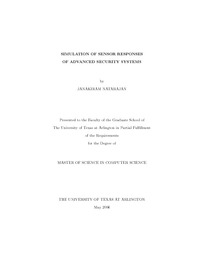
ATTENTION: The works hosted here are being migrated to a new repository that will consolidate resources, improve discoverability, and better show UTA's research impact on the global community. We will update authors as the migration progresses. Please see MavMatrix for more information.
Show simple item record
| dc.contributor.author | Natarajan, Janakiram | en_US |
| dc.date.accessioned | 2007-08-23T01:56:53Z | |
| dc.date.available | 2007-08-23T01:56:53Z | |
| dc.date.issued | 2007-08-23T01:56:53Z | |
| dc.date.submitted | June 2006 | en_US |
| dc.identifier.other | DISS-1299 | en_US |
| dc.identifier.uri | http://hdl.handle.net/10106/502 | |
| dc.description.abstract | Security systems are becoming an increasingly important area of research. Advanced security detection and surveillance systems that integrates a variety of detection mechanisms, like signals from different kinds of sensors, is expected to yield more accurate assessment than any one sensor analyzed individually. Designing and investigating these systems, to date, has relied primarily on physical deployments and experimentation. While the quality of the results from such efforts is excellent, the need to work with the physical systems directly imposes a substantial research impediment. One obvious possibility for widening the scope of what can be investigated is to employ simulation as an alternative to experimentation with deployed systems.
Our goal is to develop a simulator for simulating infrared, millimeter wave and metal detector sensor systems. The simulator was developed using the Java 2D API. The data obtained from the simulator and the real systems were processed using the WEKA library of machine learning tools to produce threat classifiers which in turn were to be compared in order to establish the accuracies of the simulator with respect to the real system. We used t-test to compare the classification accuracies obtained using the real and simulation data. The P-value obtained from the t-test showed that the differences between the two distributions could be due to chance only. We also found that the simulated data helps in increasing the classification accuracy of the threat classifiers when it is combined with the real data. Also the agreement between threat classifiers obtained using simulated and combined data validated the accuracy of our simulator. We believe that the simulator can serve as a cost effective alternate tool for studying the characteristics of the security systems and help in constructing better threat classifiers. | en_US |
| dc.description.sponsorship | Holder, Lawrence B. | en_US |
| dc.language.iso | EN | en_US |
| dc.publisher | Computer Science & Engineering | en_US |
| dc.title | Simulation Of Sensor Responses Of Advanced Security Systems | en_US |
| dc.type | M.S. | en_US |
| dc.contributor.committeeChair | Holder, Lawrence B. | en_US |
| dc.degree.department | Computer Science & Engineering | en_US |
| dc.degree.discipline | Computer Science & Engineering | en_US |
| dc.degree.grantor | University of Texas at Arlington | en_US |
| dc.degree.level | masters | en_US |
| dc.degree.name | M.S. | en_US |
Files in this item
- Name:
- umi-uta-1299.pdf
- Size:
- 1.779Mb
- Format:
- PDF
This item appears in the following Collection(s)
Show simple item record


